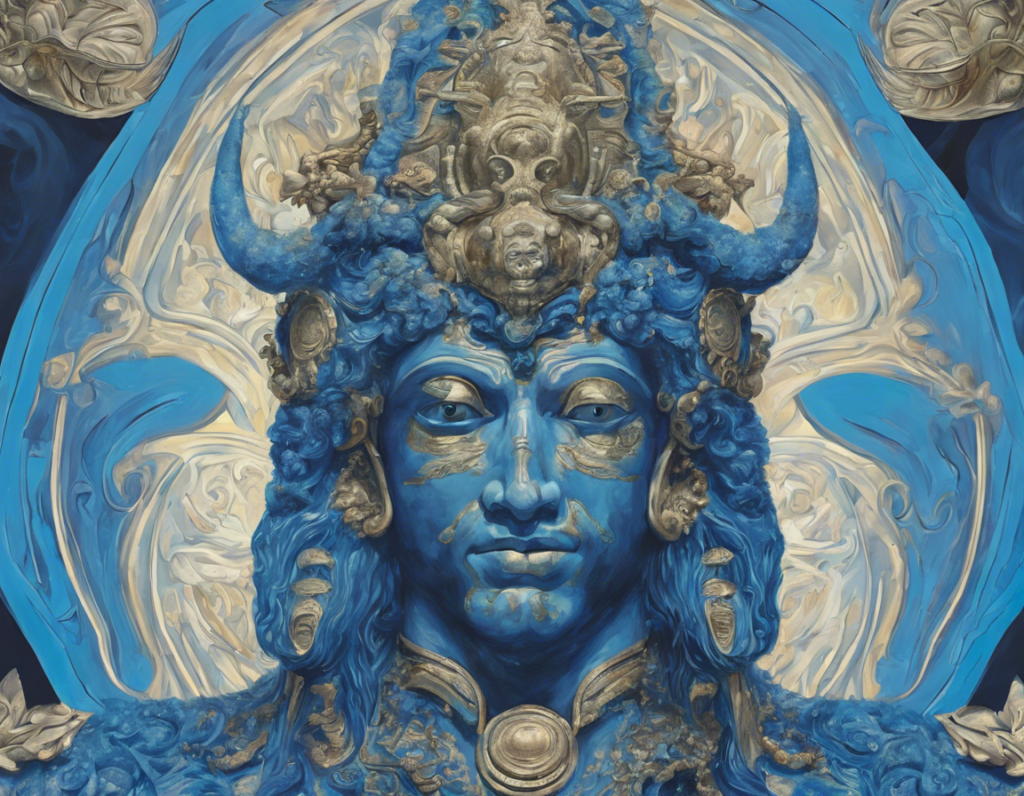Introduction
Blue God figures prominently in various myths, religions, and cultures across the world. The enigmatic nature of these deities has sparked curiosity and intrigue among scholars and enthusiasts alike. This comprehensive exploration delves into the origins, significance, and cultural interpretations surrounding Blue Gods.
Origins of Blue Gods
Blue Gods have deep roots in ancient mythologies and pantheons. In Hinduism, Lord Krishna, with his bluish complexion, is often referred to as the Blue God. According to Hindu beliefs, the color blue symbolizes the infinite and the vast expanse of the sky. Lord Krishna is revered as a divine figure who embodies love, joy, and compassion, attributes that resonate with his blue color.
In Egyptian mythology, the god Amun was occasionally depicted with a blue skin tone, symbolizing his association with the sky and the heavens. The color blue was also linked to fertility and rebirth in Egyptian culture, further enhancing the significance of Blue Gods.
Furthermore, in Mesoamerican civilizations, the god Tezcatlipoca was portrayed with a prominent blue color, representing his dual nature as both a beneficent and malevolent deity. The Blue God motif in Mesoamerican art and iconography reflected themes of creation, destruction, and transformation.
Significance of Blue Gods
The depiction of Blue Gods holds profound symbolic significance across different cultures and traditions. The color blue is often associated with various attributes and qualities that Blue Gods embody:
-
Spiritual Depth: Blue symbolizes the infinite and the divine realm, representing transcendence and spiritual enlightenment. Blue Gods are often seen as cosmic beings who possess profound wisdom and insight.
-
Protection and Guidance: In many traditions, Blue Gods are revered as protectors and guides who watch over their devotees and offer solace in times of need. Their benevolent presence is believed to bring comfort and reassurance to believers.
-
Healing and Purification: The color blue is associated with healing energies and purifying qualities. Blue Gods are often invoked in rituals and ceremonies aimed at promoting physical, emotional, and spiritual well-being.
-
Creativity and Inspiration: Blue is linked to creativity, imagination, and artistic expression. Blue Gods are seen as patrons of the arts, inspiring devotees to explore their creative potential and pursue artistic endeavors.
Cultural Interpretations of Blue Gods
The portrayal of Blue Gods varies across different cultures, reflecting diverse interpretations and beliefs:
-
In Indian mythology, Lord Shiva, the destroyer and transformer, is often depicted with blue skin, symbolizing his eternal and transcendent nature. His Blue God form represents the limitless expanse of consciousness and the cosmic dance of creation and destruction.
-
In ancient Egypt, the god Amun was associated with the color blue, signifying his role as a creator deity and the ruler of the sky and the heavens. The blue hue of Amun symbolized his omnipotence and divine authority.
-
In Aztec mythology, the god Huitzilopochtli was sometimes portrayed with a blue tinge, representing his connection to the sun and the heavens. As a warrior deity, Huitzilopochtli was revered for his strength, courage, and protective powers.
The Mystical Aura of Blue Gods
The enigmatic aura surrounding Blue Gods has captivated the imaginations of artists, philosophers, and mystics throughout history. The mystical symbolism of the color blue, combined with the divine attributes of Blue Gods, has inspired profound contemplation and reverence among spiritual seekers and believers.
Exploring the Archetypes of Blue Gods
The archetype of the Blue God transcends cultural boundaries and resonates with universal themes and motifs:
-
The Blue God archetype embodies the quest for spiritual enlightenment and self-realization, inviting individuals to explore the depths of their consciousness and discover their divine essence.
-
Blue Gods often symbolize the union of opposites, reconciling dualities such as light and darkness, creation and destruction, and order and chaos. They exemplify the harmonious balance of diverse forces within the cosmos.
-
The mythic narratives surrounding Blue Gods reflect timeless truths and eternal principles that speak to the human experience. Their stories inspire awe, wonder, and contemplation, inviting individuals to reflect on the mysteries of existence and the cosmic order.
FAQs About Blue Gods
- Are Blue Gods exclusively male figures in mythology and religion?
-
While many Blue Gods are depicted as male deities, there are also female counterparts, such as Blue Goddesses or deities with both male and female attributes represented in a blue hue.
-
What are some common rituals or practices associated with worshipping Blue Gods?
-
Devotees may engage in prayer, meditation, chanting of mantras, offering of incense, flowers, or food, and participation in festivals or ceremonies dedicated to Blue Gods.
-
Do all cultures interpret the color blue in the same way when it comes to the divine?
-
The symbolic meanings of colors, including blue, can vary significantly across cultures, highlighting the diversity of interpretations and associations with Blue Gods.
-
Are there any modern interpretations or representations of Blue Gods in contemporary art or popular culture?
-
Contemporary artists and creators often draw inspiration from traditional myths and legends to reinvent Blue Gods in various forms, from literature and film to visual arts and fashion.
-
How do individuals connect with the energy or essence of Blue Gods in their personal spiritual practices?
- Practices such as meditation, visualization, and ritual invocation can help individuals attune to the transformative energies and qualities embodied by Blue Gods for healing, guidance, and inspiration.
Conclusion
The mythic allure and symbolic richness of Blue Gods continue to fascinate and inspire seekers of truth and wisdom. As embodiments of divine mysteries and cosmic forces, Blue Gods invite us to explore the depths of our souls, transcend duality, and embrace the infinite possibilities of the universe. In their transcendent form, Blue Gods beckon us to awaken to the timeless truths and eternal verities that unite all of creation in a sacred dance of light and shadow, creation and dissolution.
